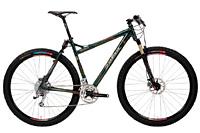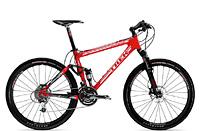
Recently on Cyclingnews.com |
Tech feature: 29in vs 26in MTBs, March 16, 2006Stepping on twenty-nine inch landminesOne of the most heated debates in bike technology at the moment is between adherents of the relatively new "29-inch" wheel size for mountain bikes and users of regular wheel sizes. Over the next few months we'll be taking a look at the pros and cons of the new format. To start with, Cyclingnews mountain bike editor Steve Medcroft looks at the passions stirred by a recent article on the topic. After we published a short feature about Durango-based ultra-endurance mountain biker Dave Harris' performance test between his 26-inch and 29-inch format bikes, Harris received a lot of feedback. “I got quite a few comments on my blog,” he says. “There were a hundred-ish emails in my in-box too (all but a couple are positive, thank goodness), and the (mountain biking) forums are going nuts over it.” Cyclingnews received its fair share of feedback too. Ryan Atkinson, assistant brand manager for Gary Fisher, Lemond and Klein Bicycles, wrote that he felt Harris' study lacked scientific credibility. He alluded to way Harris' went about his comparison of the two formats with a point summed up pretty well by reader Jay Parkhill of Menlo Park, California. “…it sounds like this test was run between a full suspension bike and a soft tail. It is very nice that Mr. Harris tried to normalize gearing and tire choices, but the difference in frame designs seems like a huge uncontrolled variable.” James Huang, a Cyclingnews tech writer and founder of www.angryasian.com (a mountain bike suspension Web site) agrees with Parkhill. “It's probably difficult to do a real study with two bikes with such a different suspension system,” he said. The difference in the suspension system between a Fuel and a Dos Niner could easily account for a five percent performance gap.” Jason Boucher, general manager for Salsa Cycles, says that although he understands the article was about “Dave's personal results on his personal bikes at this one event,” he would have preferred us to include more specifications on how Harris' built up the two bikes. “To get really accurate and repeatable results between a 26-inch and a 29-inch wheeled bike,” Boucher said, “you need to minimize the differences between the two test subjects. We need to know Harris' wheel and component spec. Simply stating the bikes weighed about the same and the tires were the same brand and model isn't enough.” Boucher also thinks there's more to performance than the ability to output wattage (the measure Harris used to draw his conclusion). “Is Wattage the only factor to performance? Dave himself even stated in your article that he was having more "fun" on the big wheels. What about comfort? Big wheels are more comfortable and this is one of the reasons many of the endurance folks are riding them.” So why the big reaction? The article was, after all, a small story about a guy who decided to see which of his own two bikes was better for him when racing? Twenty-nine inch wheeled mountain bikes have a huge and passionate following. The question of whether the format is superior over its smaller-wheeled but more widely commercially available cousin has been asked of the two-niner set for years. And the answers have all been the same; two-niners flow better over small obstacles, are more efficient for sustained climbing, take nothing away from a rider's efficiency on neutral or technical terrain and (the most repeated theme and one that Harris himself echoes) they are just more fun to ride. The only flaw in those answers is that they, like Harris' own study, don't come with unimpeachable scientific evidence. Harris has always been careful to say that the reason he ever built Power Tap wheels for his two bikes in the first place was because he could find no empirical evidence that the two-niner format was better. “The only thing I found was a technical paper published on the Gary Fisher Web site, (The Effects of Mountain Bike Wheel Size on Performance in Uphill and Cross-Country Cycling by J.T. Herr and Holden S-H. McRae, Department of Sports Medicine, Pepperdine University, Malibu, CA). But it was only an abstract.” Can it be true that no one has done a complete, scientific study on the performance differences between two-niners and two-sixers? Absolutely not says Atkinson and points readers right back to the study Harris says only whetted his appetite. Although they admit they haven't had time to complete the full peer-review document for publication, the authors of that study did their best to summarize the methods they used to draw the conclusion that “Larger circumference wheels improve mountain bike performance during climbing and cross-country riding, with no detrimental effect on cardiovascular (heart rate) or muscle function (power output).” Author Holden MacRae says they started the test with a simple theory. “Our null hypothesis was that there would be no difference in performance between a two-niner and a regular-wheeld bike.” MacRae and his partner then measured cyslists on both an uphill and a cross-country course. “Fisher sent us two bikes with identical components to do the test,” wrote MacRae in response to our emailed questions about the study. “ We instrumented the biked with SRM Cranks and also fitted both with similar tires.” They used six sub-elite riders for the test. “Testing was done in March, April and May (of 2003). One round of laboratory testing was done to characterize the performance of the test riders and then we did two separate sessions on trails.” The uphill trial was done on an approximately one-mile stretch of fire road and the cross-country test on an approximately three-mile loop. “The subjects also carried a portable gas analyzer (VO2000 model) so that we could get VO2 data.” The published summary says that the result of these tests is that, “the average times of the sic cyclists tested were four percent faster (17 seconds) on the uphill course, and three percent (26 seconds) on the XC course when riding the 29-inch equipped bicycle. If one extrapolates the duration of these trials to typical ride/race times of 1.5 or 2 hours, then it is likely that significant performance differences can accrue by riding a 29-inch equipped bicycle,” the study concludes. MacRae and Herr wrote that they, “attribute the faster course completion times on the 29-inch vs. 26-inch bicycle to the larger wheel traveling a greater distance per pedal revolution (average power outputs were not different between bicycles), and likely to a cumulative effect of the larger wheels rolling faster and more easily over obstacles during the uphill and cross-country trials.” As an elite level racer, Haris believes that the MacRae/Herr study doesn't answer his specific question – which format is better for racing? And, he says, he's done some thinking about how he'd re-do his now famous comparison differently. “Ideally, I'd do the same test but with bikes that are a lot closer to each other. Gary Fisher is coming out with the Race Day Platform, a 3-inch travel bike that is going to be available in both 26-inch and 29-inch flavors. That's probably the way to go.” Jason Boucher of Salsa Cycles says that even if more testing was done, it won't change the hearts of those who know and love the format. “This is simply a question that will be continually discussed, even if there is scientific and conclusive data. It's like asking what brand is better or what suspension system is best? Riders like to make their own decisions and people will often dismiss data because they have a different perception or intended use for the product. Here at Salsa, we promote having fun on your bike. We don't care if you ride 26 or 29! What we do care about is making fun, durable, performance and niche bikes that serve your intended use.” So what did Dave Harris accomplish with his personal experiment? Well, for one, he accomplished what he set out to do – figure out which of his two bikes is the better one for him to take to a 24-hour race. Secondly, and perhaps unintentially, he challenged the two-niner community to not just tell him that he should be riding a two-niner, but to tell him why. So the next chapter in the saga will be that we should take a closer look at the question. Can Cyclingnews play a role? Stay tuned. |



